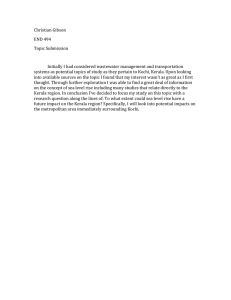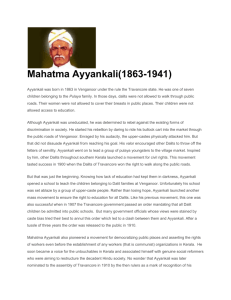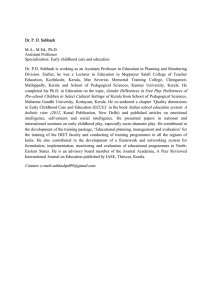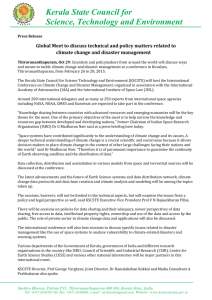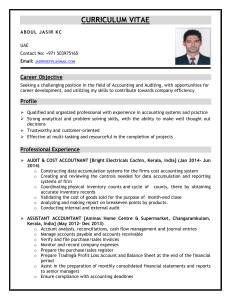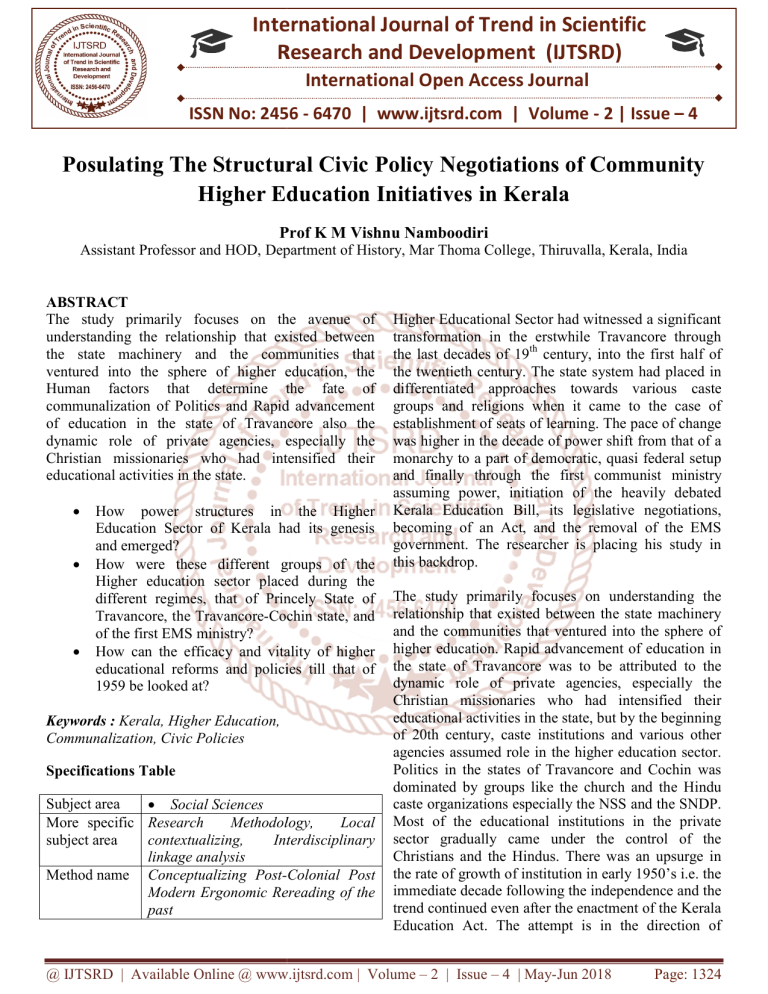
International Journal of Trend in Scientific
Research and Development (IJTSRD)
International Open Access Journal
ISSN No: 2456 - 6470 | www.ijtsrd.com | Volume - 2 | Issue – 4
Posulating The Structural Civic P
Policy
olicy Negotiations of Community
Higher Education Initiatives in Kerala
Prof K M Vishnu Namboodiri
Assistant Professor and HOD, Department of History, Mar Thoma College
College, Thiruvalla,
Thiruvalla Kerala, India
ABSTRACT
The study primarily focuses on the avenue of
understanding the relationship that existed between
the state machinery and the communities that
ventured into the sphere of higher education, the
Human
uman factors that determine the fate of
communalization of Politics and Rapid advancement
of education in the state of Travancore also the
dynamic role of private agencies, especially the
Christian missionaries who had intensified their
educational activities in the state.
How power structures in the Higher
Education Sector of Kerala had its genesis
and emerged?
How were these different groups of the
Higher education sector placed during the
different regimes, that of Princely State of
Travancore, the Travancore-Cochin
Cochin state, and
of the first EMS ministry?
How can the efficacy and vitality of higher
educational reforms and policies till that of
1959 be looked at?
Keywords : Kerala, Higher Education,
Communalization, Civic Policies
Specifications Table
Subject area
Social Sciences
More specific Research
Methodology,
Local
subject area
contextualizing,
Interdisciplinary
linkage analysis
Method name Conceptualizing Post--Colonial Post
Modern Ergonomic Rereading of the
past
Higher Educational Sector had witnessed a significant
transformation in the erstwhile Travancore through
the last decades of 19th century, into the first half of
the twentieth century. The state system had placed in
differentiated approaches towards various
variou caste
groups and religions when it came to the case of
establishment of seats of learning. The pace of change
was higher in the decade of power shift from that of a
monarchy to a part of democratic, quasi federal setup
and finally through the first communist
commu
ministry
assuming power, initiation of the heavily debated
Kerala Education Bill, its legislative negotiations,
becoming of an Act, and the removal of the EMS
government. The researcher is placing his study in
this backdrop.
The study primarily focuses
es on understanding the
relationship that existed between the state machinery
and the communities that ventured into the sphere of
higher education. Rapid advancement of education in
the state of Travancore was to be attributed to the
dynamic role of private
te agencies, especially the
Christian missionaries who had intensified their
educational activities in the state, but by the beginning
of 20th century, caste institutions and various other
agencies assumed role in the higher education sector.
Politics in the
he states of Travancore and Cochin was
dominated by groups like the church and the Hindu
caste organizations especially the NSS and the SNDP.
Most of the educational institutions in the private
sector gradually came under the control of the
Christians and the Hindus. There was an upsurge in
the rate of growth of institution in early 1950’s i.e. the
immediate decade following the independence and the
trend continued even after the enactment of the Kerala
Education Act. The attempt is in the direction of
@ IJTSRD | Available Online @ www.ijtsrd.com | Volume – 2 | Issue – 4 | May-Jun
Jun 2018
Page: 1324
International Journal of Trend in Scientific Research and Development (IJTSRD) ISSN: 2456-6470
observing the pattern of structure of activity that
evolved between various entities that involved in the
arena of institutionalization of education. The ProCaste Hindu policies of the Travancore state
especially during the Dewanship of Sir C. P
Ramaswami Iyer, and the alienation or the relative
absence of Syrian Christian communities and
Institutions till the early 1950’s find a place in the
study. The enquiry into the approximate absence of
institutions run by the so called ‘Dalit communities’
and the marginalized and the weaker sections in the
era of “Kerala Renaissance” amuses the researcher.
The dynamics of Power balance mechanism in this
regard is an area where the researcher wants to dwell
deep.
1. JUSTIFICATION FOR THE EFFICACY OF
THE STUDY
Locating the efficacy and vitality of higher
educational reforms and policies of the Princely
State of Travancore, the Travancore-Cochin state,
and of the first EMS ministry, and thereby tracing
the development of the pattern of relationships
that evolved between the different entities in the
higher education system.
Locating the contextual genesis of community
initiatives together with addressing, delineating
and locating the space and intervention of the
state, societal actors, organized non-state groups
and judiciary in the arena of higher education.
Whole of the policies and reforms in the higher
education sector of Kerala including the Kerala
Education Act remined flexibly adjusted for the
interest of dominant Hindu caste groups with subaccommodation of the interest of the Christian and
influential Muslim groups, albeit creating the
pseudo-impression of inclusiveness towards the
marginalized and the “Dalit communities” and
when the traditional power centers were affected
the various groups united as a force and checked
the state machinery and policies from curbing
their influence, clout and privileges
2. THE GREEN PATCH FOR RESEARCHERS
How power structures in the Higher Education
Sector of Kerala had its genesis and emerged?
How were these different groups of the Higher
education sector placed during the different
regimes, that of Princely State of Travancore,
the Travancore-Cochin state, and of the first
EMS ministry?
How can the efficacy and vitality of higher
educational reforms and policies till that of
1959 be looked at?
What are the methods of analyzing the
development of the pattern of relationships
that evolved between the different entities in
the higher education system?
This study is a qualitative research and shall be interdisciplinary in nature without compromising the
essence of historical methodology. As the study is
primarily exploratory in nature the researcher also
intends to carry out interview with the real players
and stakeholders who include officials, academia and
public. The study shall be nourished with real time
survey as well. The style of writing may hover from
theoretical space to descriptive space and vice-versa.
The researcher at this juncture feels that a negotiation
between Marxian methodology and the feminist angle
is an imperative to this study as to address the real
issues pertaining to marginalization, alienation and
depravation of basic amenities and resources.
Researcher is confident that as the study progress
sound theoretical and non–self-contradicting idea and
tools can be arrived at.
Additional information:
Umpteen numbers of studies pertaining to the
Educational history of Kerala has been carried out by
researchers in various fields and discipline, which has
indeed contributed in nourishing the outlook and
perspective of the researcher in reaching the topic. An
array of secondary published works is at disposal
which includes, Education and Social Mobility: The
Kerala Experience by Sri PT Thomas which focuses
on the provision of basic social services, in particular,
access to education, as the cardinal building blocks of
any human development strategy, the work also
signifies a substantial contribution towards the central
role of education in social mobility. Social
Development and Demographic Changes in South
India: Focus on Kerala, By V. Balakrishnan Nair is
yet another work which focuses on some unique
aspects of community initiatives carried out, which
improved the education sector of Kerala, as reflected
through data, like that of literacy rate, which in
Travancore had been merely 12.4 % and that of
cochin being 13.3% in 1901. A few unpublished
research thesis’s in the field of Economics, Political
@ IJTSRD | Available Online @ www.ijtsrd.com | Volume – 2 | Issue – 4 | May-Jun 2018
Page: 1325
International Journal of Trend in Scientific Research and Development (IJTSRD) ISSN: 2456-6470
Science and Education have also helped the
researcher to arrive at the topic that includes Political
economy of educational initiatives in Kerala by Dr M
S James, Politics of educational management: a case
study of the Christian minority in Kerala by Dr Ruble
Raj, Educational policy of the Government of India
during the British Period by Samuel Raj A, History
education at the secondary school level in Kerala state
a critical study by Promod VS, among others.
References:
1) AIYA, V. NAGAM, THE TRAVANCORE
STATE MANUAL, VOL. II. AND VOL IIL
(TRIVANDRUM: THE GOVERNMENT OF
TRAVANCORE. 1906).
2) AIYAR, S. RARNANATH, PROGRESSIVE
TRAVANCORE.
{TRIVANDRUM:
THE
ANANTHA RAMA VANNA PRESS, 1923).
3) CHAUBE, S.P., A HISTORY OF EDUCATION
IN INDIA. (ALLAHABAD: NAV SAHITYA
PRESS, 1965).
4) DAVIES,
INDIAN.
1923).
F.S., COCHIN, BRITISH AND
(MADRAS: DIOCESAN PRESS,
5) POLITICAL
AND
ADMINISTRATIVE
INTEGRATION OF PRINCELY STATES, S. N.
SADASIVAN, MITTAL PUBLICATIONS, 2005
6) EDUCATION AND SOCIAL MOBILITY: THE
KERALA EXPERIENCE, P.T THOMAS,
NORTON PRESS, 2005
12) POLITICS
OF
EDUCATIONAL
MANAGEMENT: A CASE STUDY OF THE
CHRISTIAN MINORITY IN KERALA BY DR
RUBLE RAJ, UNPUBLISHED PH D THESIS
PERUSED VIA MG UNIVERSITY ONLINE
THESIS REPOSITORY.
13) EDUCATIONAL
POLICY
OF
THE
GOVERNMENT OF INDIA DURING THE
BRITISH PERIOD BY SAMUEL RAJ A,
UNPUBLISHED PH D THESIS PERUSED VIA
MG
UNIVERSITY
ONLINE
THESIS
REPOSITORY.
14) HISTORY
EDUCATION
AT
THE
SECONDARY SCHOOL LEVEL IN KERALA
STATE A CRITICAL STUDY BY PROMOD
VS, UNPUBLISHED PH D THESIS PERUSED
VIA MG UNIVERSITY ONLINE THESIS
REPOSITORY.
15) HISTORY OF EDUCATION IN PRINCELY
STATE OF TRAVANCORE IN SOCIO
ECONOMIC AND POLITICAL PERSPECTIVE,
DR S NOORGEHAN, UNPUBLISHED PH D
THESIS PERUSED VIA MG UNIVERSITY
ONLINE THESIS REPOSITORY.
16) VELU PILLAI, T.K., TRAVANCORE STATE
MANUAL VOL. III. (TRIVANDRUM: THE
GOV2RNMENT OF TRAVANCORE, 1940).
17) HISTORY AND DEVELOPMENT OF HIGHER
EDUCATION IN KERALA, G RAVINDRAN,
UNPUBLISHED THESIS UNIVERSITY OF
KERALA 1999
7) SOCIAL
DEVELOPMENT
AND
DEMOGRAPHIC CHANGES IN SOUTH
INDIA:
FOCUS
ON
KERALA,
V.
BALAKRISHNAN NAIR
8) TRAVANCORE
EDUCATION
CODE,
GOVERNMENT PRESS TRAVANCORE 1941
9) THE KERALA EDUCATION ACT – 1958 (ACT
6 OF 1959)
10) NOTIFICATION NO. ED(C.SPL) 21564/59/EHD
DATED 27TH MAY 1959, PUBLISHED IN
GAZETTE EXTRAORDINARY DATED 27TH
MAY 1959, ACT 35 OF 1960
11) POLITICAL ECONOMY OF EDUCATIONAL
INITIATIVES IN KERALA DR M S JAMES,
UNPUBLISHED PH D THESIS PERUSED VIA
MG
UNIVERSITY
ONLINE
THESIS
REPOSITORY.
@ IJTSRD | Available Online @ www.ijtsrd.com | Volume – 2 | Issue – 4 | May-Jun 2018
Page: 1326

